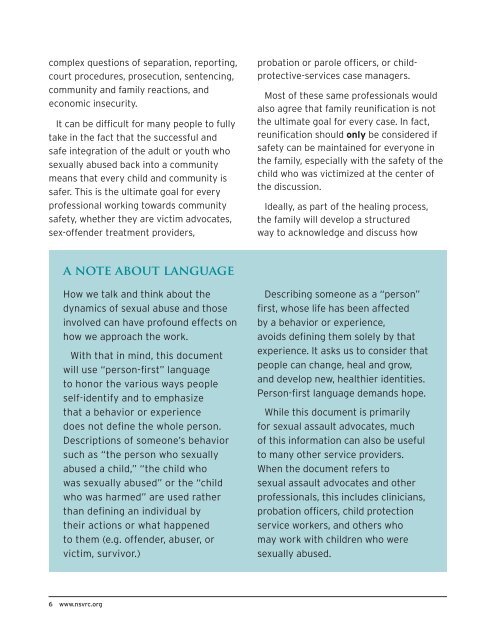Considering Family Reconnection and Reunification after Child Sexual Abuse
1VwGeds
1VwGeds
Create successful ePaper yourself
Turn your PDF publications into a flip-book with our unique Google optimized e-Paper software.
complex questions of separation, reporting,<br />
court procedures, prosecution, sentencing,<br />
community <strong>and</strong> family reactions, <strong>and</strong><br />
economic insecurity.<br />
It can be difficult for many people to fully<br />
take in the fact that the successful <strong>and</strong><br />
safe integration of the adult or youth who<br />
sexually abused back into a community<br />
means that every child <strong>and</strong> community is<br />
safer. This is the ultimate goal for every<br />
professional working towards community<br />
safety, whether they are victim advocates,<br />
sex-offender treatment providers,<br />
probation or parole officers, or childprotective-services<br />
case managers.<br />
Most of these same professionals would<br />
also agree that family reunification is not<br />
the ultimate goal for every case. In fact,<br />
reunification should only be considered if<br />
safety can be maintained for everyone in<br />
the family, especially with the safety of the<br />
child who was victimized at the center of<br />
the discussion.<br />
Ideally, as part of the healing process,<br />
the family will develop a structured<br />
way to acknowledge <strong>and</strong> discuss how<br />
A note about language<br />
How we talk <strong>and</strong> think about the<br />
dynamics of sexual abuse <strong>and</strong> those<br />
involved can have profound effects on<br />
how we approach the work.<br />
With that in mind, this document<br />
will use “person-first” language<br />
to honor the various ways people<br />
self-identify <strong>and</strong> to emphasize<br />
that a behavior or experience<br />
does not define the whole person.<br />
Descriptions of someone’s behavior<br />
such as “the person who sexually<br />
abused a child,” “the child who<br />
was sexually abused” or the “child<br />
who was harmed” are used rather<br />
than defining an individual by<br />
their actions or what happened<br />
to them (e.g. offender, abuser, or<br />
victim, survivor.)<br />
Describing someone as a “person”<br />
first, whose life has been affected<br />
by a behavior or experience,<br />
avoids defining them solely by that<br />
experience. It asks us to consider that<br />
people can change, heal <strong>and</strong> grow,<br />
<strong>and</strong> develop new, healthier identities.<br />
Person-first language dem<strong>and</strong>s hope.<br />
While this document is primarily<br />
for sexual assault advocates, much<br />
of this information can also be useful<br />
to many other service providers.<br />
When the document refers to<br />
sexual assault advocates <strong>and</strong> other<br />
professionals, this includes clinicians,<br />
probation officers, child protection<br />
service workers, <strong>and</strong> others who<br />
may work with children who were<br />
sexually abused.<br />
6 www.nsvrc.org


